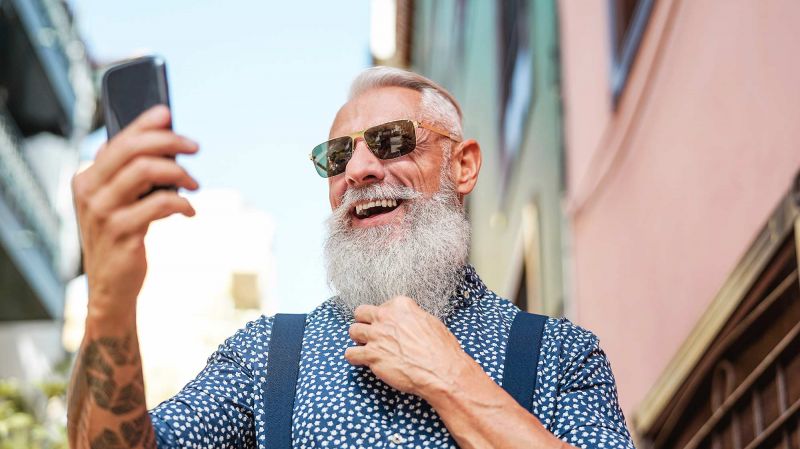Marketers Must Get Past Those Tired Seniors' Stereotypes
In advertising, older people are either solely frail or globetrotting go-getters. The reality: they’re often both

Think of the last time you saw someone over 55 in an ad. Chances are they were either getting into one of those walk-in tubs, buying Depends or living their best life on a European cruise. Or maybe you can’t remember the last time you saw a senior in an ad. You wouldn’t be alone.
A 2019 study by the American Association of Retired Persons found that while 46 per cent of U.S. adults are 50-plus, only 15 per cent of online images include adults in this age group. Ad agency Havas Group’s findings are even starker: only about five per cent of all U.S. advertising is aimed at people over 50.
What may be more striking is that the number of people over 60 in the developed world is expected to grow to 33 per cent of the population by 2050 from 24 per cent in 2015. And these seniors have money to spend. Here in Canada, baby boomers are the wealthiest of any generation, with an average net worth of $1.2 million.
Clearly, this is a group you’d think marketers desperately want to reach. And yet they aren’t, or at least not well. Why?
One reason is that, in general, the discipline of marketing relies more or less on stereotypes, says Monica LaBarge, assistant professor at Smith School of Business.
“Target customers are still often described based primarily on demographic characteristics,” she says. “It’s an overly simplistic way of looking at people. And so when you start to consider things as complicated as your emotional, physical and cognitive capacity, marketing isn’t set up to be nuanced like that.”
There are signs that’s changing, however, though slowly. And a recent research paper by LaBarge and Ryerson University’s Martin Pyle may help.
Entitled “Staying in ‘the works of living’: How older adults employ marketplace resources to age successfully,” the paper was published in the Journal of Consumer Affairs. Drawing on marketing and gerontology research, and using in-depth interviews with 17 adults aged 65 to 93, LaBarge and Pyle present a model that gives marketers a more nuanced perspective of how older consumers navigate the marketplace.
What Bonnie said
Traditionally, research—and marketing practices in general—have placed older adults in two categories, says LaBarge. On one hand, they are seen as vulnerable consumers characterized by powerlessness, dependence and a reduced capacity to ensure their own best interests in the marketplace. On the other, they are successfully aging consumers with the capacity to function in the marketplace to their satisfaction regardless of any physical, mental or social limitations.
LaBarge and Pyle, however, incorporate both perspectives in their model and place them at opposite ends of a continuum. In short, older adults are “neither solely frail or globetrotting go-getters,” says LaBarge. “There is something in between, and people may move along this continuum depending on what aspect of their life you’re talking about.”
Take one’s living arrangement, for example. When LaBarge interviewed older adults for the study and asked them about their decision to either live independently or with some type of assistance, several clearly showed the fluidity with which they can move along the continuum.
Bonnie, for instance, is a 91-year-old widow living alone in an apartment who talked about her conflicting feelings about moving to a nursing home, where she is on the waiting list.
“The way I feel today, if they phoned me I'd say, ‘No thanks,’ ” she said. “But there are days when I don't feel very well … there are times when I wish—oh, especially in the night you wake up and it's dark … if I were in the nursing home I would ring for a nurse, and I know there are people around. Whereas here, who am I going to call at that hour? So I deal with it myself the best way I can.”
A complete life
So what do marketers do with a consumer like Bonnie who shows anxiety about giving up some, or all, of her independence? Typically, not much. But LaBarge says they should take a look at the marketplace data and see that older adults clearly have a wide range of preferences when it comes to living arrangements.
Surprisingly, it’s non-profits and grassroots organizations that have tried to satisfy that fluidity through creative solutions like retirement villages, says LaBarge. These are communities where older adults live in their own homes but purposefully create connections with others for social and practical reasons, such as vetting service providers.
“It might be challenging for corporations to do this too, but not impossible,” says LaBarge. “And certainly there’s a large market for it.”
LaBarge saw a similar need for a wider range of marketplace choices when she asked seniors about travel, money management, health and hobbies. And across all of these contexts, she identified three broad categories of approaches that respondents use to manage their consumption concerns: self-determination, trust and connection, and perspective.
But there is complexity here, too, as the respondents don’t all use the categories in the same way. Some embrace aging and planning (self-determination) and develop a network of service providers (trust and connection). Others do the opposite. Many, of course, do something in between. And again, marketers need to do a better job of understanding—and responding to—that “in between”, says LaBarge.
Though it’s easy to think of senior consumers as mostly vulnerable and frail, LaBarge says she hopes her research recasts older adults as “the powerful and complex consumers they are.” As she and Pyle write in their paper: “Our findings demonstrate that older adults see themselves as full and complete human beings with aspirations, relationships, and visions for their future.”